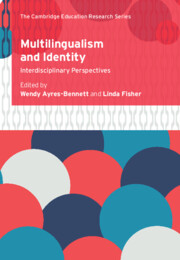Book contents
- Multilingualism and Identity
- Multilingualism and Identity
- Copyright page
- Contents
- Figures
- Tables
- Contributors
- 1 Towards Interdisciplinarity in Multilingual Identity Research
- Part I Situated Multilingualism and Identity
- 2 ‘Every Line Is a Lie’
- 3 Beyond ‘Narrating the Nation’
- 4 Metrolingual Practices and Distributed Identities
- 5 Migrants’ Identities in Multilingual Cities
- 6 Indexicalities in the Multilingual City
- 7 Multilingualism and Identity in Ningbo, China
- Part II Multilingual Identity Practices
- Part III Multilingual Identity and Investment
- References
- Index
7 - Multilingualism and Identity in Ningbo, China
A Case Study
from Part I - Situated Multilingualism and Identity
Published online by Cambridge University Press: 22 July 2022
- Multilingualism and Identity
- Multilingualism and Identity
- Copyright page
- Contents
- Figures
- Tables
- Contributors
- 1 Towards Interdisciplinarity in Multilingual Identity Research
- Part I Situated Multilingualism and Identity
- 2 ‘Every Line Is a Lie’
- 3 Beyond ‘Narrating the Nation’
- 4 Metrolingual Practices and Distributed Identities
- 5 Migrants’ Identities in Multilingual Cities
- 6 Indexicalities in the Multilingual City
- 7 Multilingualism and Identity in Ningbo, China
- Part II Multilingual Identity Practices
- Part III Multilingual Identity and Investment
- References
- Index
Summary
Like many other sub-fields of sociolinguistics, two seemingly unbridgeable gaps exist in the sociolinguistic study of multilingualism and identity in urban settings. First, existing studies tend to examine Western and/or English-speaking societies only; and moreover, they do so by using either quantitative or qualitative methods and rarely considering both approaches. As a result, relevant theories have been developed without taking into consideration cases outside these sites using a more comprehensive methodological approach. This chapter presents a case study of urban multilingualism in Ningbo in Eastern China to demonstrate how investigations of non-Western/non-English multilingual settings incorporating interdisciplinary methodologies can help to validate, challenge and, more importantly, expand our understanding of the sociolinguistics of multilingual identity, both theoretically and methodologically. Informed by a variationist approach and mixed-methods designs, the case study not only presents the multilingual sociolinguistic reality of Ningbo, but also shows how an interdisciplinary perspective enriches the field of sociolinguistics.
- Type
- Chapter
- Information
- Multilingualism and IdentityInterdisciplinary Perspectives, pp. 131 - 152Publisher: Cambridge University PressPrint publication year: 2022



